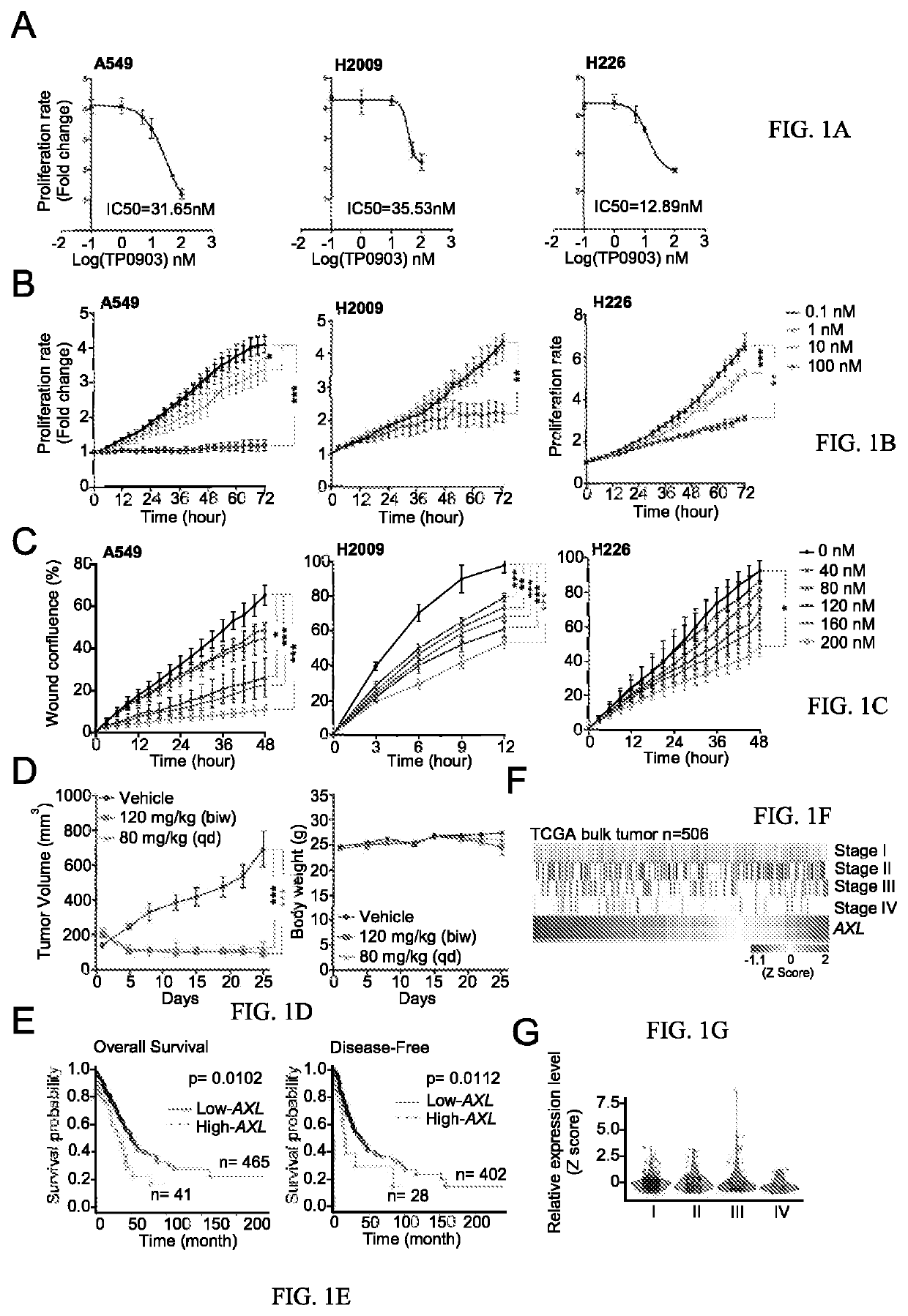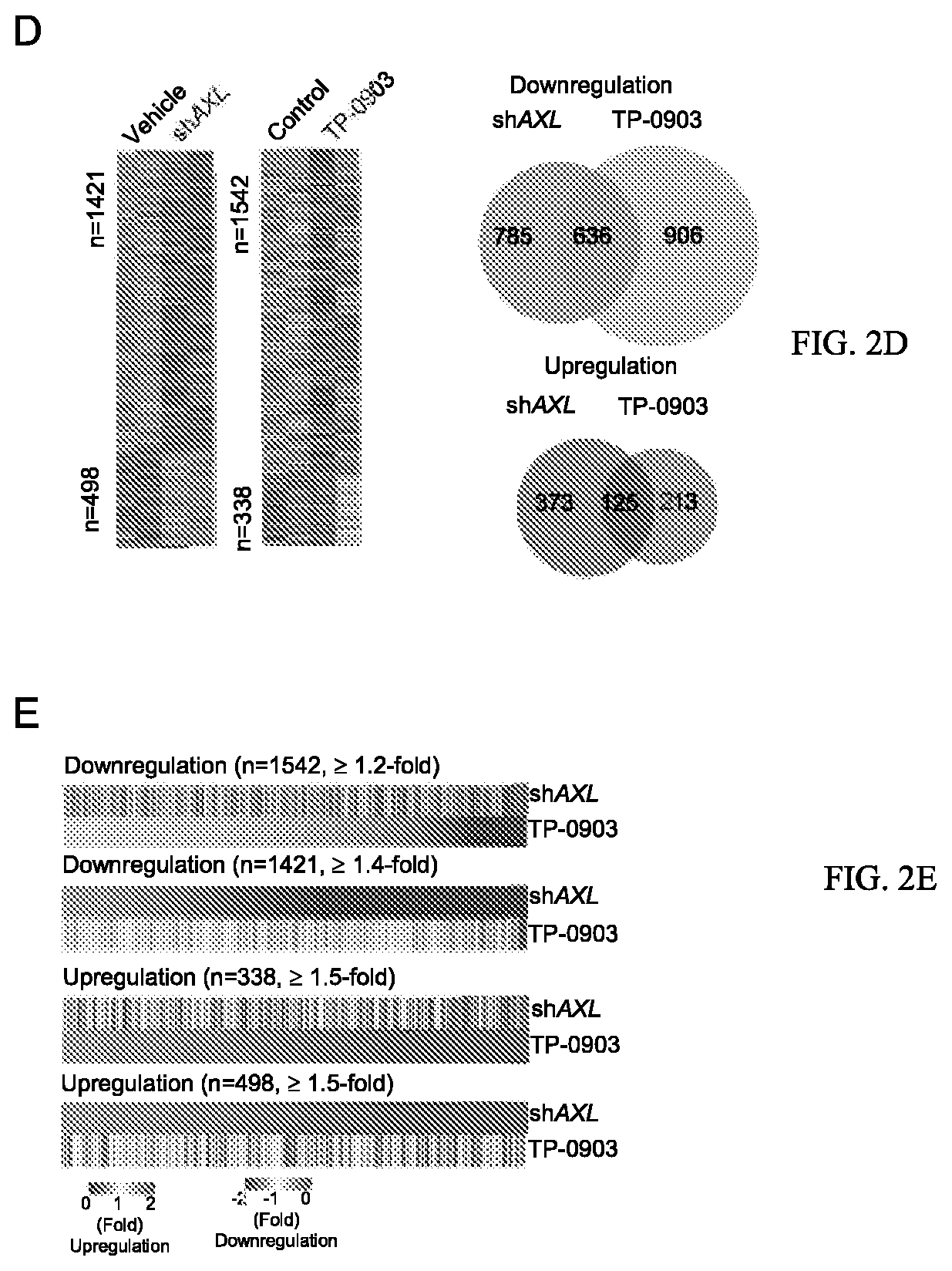Methods for predicting drug responsiveness in samples from cancer subjects
a cancer subject and drug responsiveness technology, applied in the field of methods for predicting drug responsiveness in cancer subjects, can solve the problems of drug resistance, poor survival outcomes of patients, and overexpressed axl
- Summary
- Abstract
- Description
- Claims
- Application Information
AI Technical Summary
Problems solved by technology
Method used
Image
Examples
example 1
itor TP-0903 Attenuates TGF-β-Hippo Signaling in Lung Adenocarcinoma Cells
[0204]Abstract. How TP-0903, an AXL inhibitor, influences oncogenic signaling pathways in adenocarcinoma lung cancer cells was investigated. Comparative profiling of 2963 differentially expressed genes in TP-0903-treated and AXL-knockdown cells identified complex signaling networks between AXL and non-AXL axes. Specifically, TP-0903 repressed activation of transforming growth factor β (TGF-β)-Hippo signaling via AXL. Single-cell proteomic analysis revealed that cell subpopulations had different sensitivities to TP-0903, attributed to protein expression levels of TGF-β-Hippo components in susceptible lung cancer cells. TP-0903 treatment also disturbed hybrid mesenchymal-epithelial transition features and lessened biophysical properties of aggressiveness in cancer cells. In addition to high levels of AXL activity, lung tumors exhibiting activated TGF-β-Hippo signaling are candidates for treatment with TP-0903. T...
example 2
lysis Predicts Drug Responsiveness and Potential for Metastasis in Human Patients
[0336]The data summarized herein suggests that patient006 will derive the most benefit from an AXL and / or JAK inhibitor using the CyTOF panel described herein. Further, the CyTOF panel can also predict which subjects with cancer will be more likely to relapse from their disease. The results show that for the four patients screened, patient006 has the worst cancer despite the early stage of the disease and the tumor cells show the highest potential for tumor spread based on the elevated proteins as determined by using the CyTOF panel disclosed herein.
[0337]CyTOF analysis was performed on primary lung tumors from four patients using lineage markers to profile tumor microenvironment and phenotypic markers to interrogate oncogenic pathways. Patient 002 tumor specimen represents a subcarinal lymph node from an 81-year-old female (chronic smoker) with Stage IIIA (T1N2M0) lung adenocarcinoma. Patient 004 tumor...
example 3
ll Proteomic Profiling Identifies Combined AXL and JAK1 Inhibition as a Novel Therapeutic Strategy for Lung Cancer
[0339]Abstract. Cytometry by time-of-flight (CyTOF) simultaneously measures multiple cellular proteins at the single-cell level and is used to assess inter- and intra-tumor heterogeneity. This approach may be used to investigate the variability of individual tumor responses to treatments. As described herein, lung tumor subpopulations were stratified based on AXL signaling as a potential targeting strategy. Integrative transcriptome analyses were used to investigate how TP-0903, an AXL kinase inhibitor, influences redundant oncogenic pathways in metastatic lung cancer cells. CyTOF profiling revealed that AXL inhibition suppressed SMAD4 / TGF-β signaling and induced JAK1-STAT3 signaling to compensate for the loss of AXL. Interestingly, high JAK1-STAT3 was associated with increased levels of AXL in treatment-naïve tumors. Tumors with high AXL, TGF-β and JAK1 signaling concom...
PUM
 Login to View More
Login to View More Abstract
Description
Claims
Application Information
 Login to View More
Login to View More - R&D
- Intellectual Property
- Life Sciences
- Materials
- Tech Scout
- Unparalleled Data Quality
- Higher Quality Content
- 60% Fewer Hallucinations
Browse by: Latest US Patents, China's latest patents, Technical Efficacy Thesaurus, Application Domain, Technology Topic, Popular Technical Reports.
© 2025 PatSnap. All rights reserved.Legal|Privacy policy|Modern Slavery Act Transparency Statement|Sitemap|About US| Contact US: help@patsnap.com



